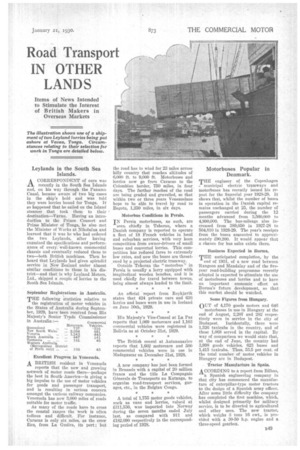Road Transport IN OTHER LANDS
Page 75

If you've noticed an error in this article please click here to report it so we can fix it.
Leylands in the South Sea Islands.
ACORRESPONDENT of ours was recently in the South Sea Islands and, on his way through the Panama Canal, became aware of two big cases in the ship's hold and was told they were lorries bound for Tonga. It so happened that he sailed on the Island steamer that took them to their destination—Vavau. Having an introduction to the Prince Consort and Prime Minister of Tonga, he also met the Minister of Works at Nikolafua and learned that it was he who had ordered the two Leylands, after having examined the specifications and performances of every, well-known commercial chassis and eventually reduced these to two—both British machines. Then he heard that LesIands had given splendid service in New Zealand under almost similar conditions to those in his district—and that is why Leyland Idotors, Ltd., shipped a couple of lorries to the South Sea Islands.
September Registrations in Australia.
THE following statistics relative TO
the registration of motor vehicles in the States of Australia during September, 1929, have been received from His Majesty's Senior Trade Commissioner in Australia:— Excellent Progress in Venezuela.
A BRITISH resident in Venezuela
reports that the new and growing network of motor roads there—perhaps the best in South' America—is giving a big impulse to the use of motor vehicles for goods and passenger transport, and is resulting in serious concern amongst the various railway companies. Venezuela has now 3,000 miles of roads suitable for motor traffic.
As many of the roads have to cross the coastal ranges the work is often tedious and difficult. For instance, Caracas is only six miles, as the crow flies, from La Guaira, its port; but
the road has to wind for 23 miles across hilly country that reaches altitudes of 6,000 ft. to 9,000 ft. Motorbuses and lorries now go from Caracas to the Colombian border, 750 miles, in four. days. The farther reaches of the road are being graded •and gravelled, so that within two or three years Venezuelans hope to be able to travel by road to Bogota, 1,250 miles, in six days.
Motorbus Conditions in Persia.
IN Persia motorbuses, as such, are seen, chiefly in Teheran' where a Danish company is reported to operate a fleet of 18 French vehicles in local and suburban services, with very keen competition from owner-drivers of small buses and converted lorries. This. competition has reduced fares to extremely low rates, and now the buses are threatened by a projected electric tramway.
Outside Teheran the " motorbus " in Persia is usually a lorry equipped with longitudinal wooden benches, and it is used chiefly for travel between towns, being almost always loaded to the limit.
An official report from Reykjavik states that 424 private cars and 636 lorries and buses were in use in Iceland on June 30th, 1929.
His Majesty's Vice-Consul at La Paz reports that 1,069 motorcars and 1,103 commercial vehicles were registered in Bolivia as at October 31st, 1929.
The British consul at Antananarivo eports that 1,602 motorcars and 500 commercial. vehicles were in use in Madagascar on December 31st, 1928.
A new company has just been formed in Brussels with a capital of 20 million francs and the title La Compagnie Generale de Transports an Katanga, to organize road-transport services, garages, etc., in the Belgian Conga.
A total of 1,755 motor goods vehicles, such as vans and lorries, valued at £311,530, was imported into Norway during the seven months ended July last, as compared with 911 and £182,090 respectively in the corresponding period of 1928.
Motorbuses Popular in Denmark.
THE engineer of the Copenhagen municipal electric tramways and motorbuses has recently issued his report for the financial year 1928-29. It shows that, whilst the number of buses in operation in the Danish capital remains unchanged at 25, the number of passengers carried during the 12 months advanced from 3,560,000 to 4,800,000. The bus-mileage also increased from 389,050 in 1927-28 to 504,810 in 1928-29. The year's receipts from the buses 'amounted to approximately £90,200. It would appear that a chance for bus sales exists there.
Business Expected in Burma.
TILE anticipated completion, by the
end of 1931, of a new road between 'Rangoon and Mandalay and of the fiveyear road-building programme recently adopted is expected to stimulate the use of motorbuses and lorries and to have an important economic effect on Burma's future development, so that this market should be watched.
Some Figures from Hungary.
01[5T of 4,170 goods motors and 646 motorbuses in use in Hungary at the end of August, 2,207 and 282 respectively were in service in the city of Budapest. Incidentally, there were 1,526 taxicabs in the country, and of these 1,068 served in the capital. By way of comparison we would state that, at the end of June, the country had 3,998 goods vehicles, 623 buses and 1,415 taxicabs. Thus, 53.5 per cent, of the total number of motor. vehicles in Hungary are in Budapest.
• Tractor Manufacture in Spain.
ACCORDING to a report from Bilbao,
a Spanish engineering company in that city bras commenced the manufacture of caterpillar-type motor tractors to the design of a Spanish army officer. After some little difficulty the company has completed the first machine, which, whilst designed primarily for military service, is to be diverted to agricultural and other uses. The new tractor, which weighs 3 tons 16 cwt., is provided with a 30-50 h.p. engine and a three-speed gearbox.




















































































































